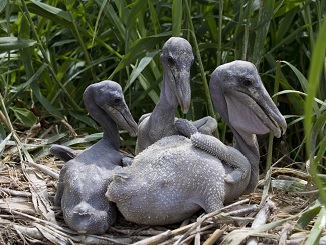 Waterbird nesting season is underway along the coast, and the N.C. Wildlife Resources Commission and ODU encourages coastal visitors to give nesting birds a wide berth when enjoying beach activities. Nesting is happening from Maine to Florida and it is important to share to coast line.
Waterbird nesting season is underway along the coast, and the N.C. Wildlife Resources Commission and ODU encourages coastal visitors to give nesting birds a wide berth when enjoying beach activities. Nesting is happening from Maine to Florida and it is important to share to coast line.
“Beach-nesting birds are a vital component of our barrier-island ecosystem and a sign of a healthy beach,” said Sara Schweitzer, the Commission’s waterbird biologist. “Visitors to our beautiful coast can have a huge impact on the success of our shorebirds and colonial nesting waterbirds, so we encourage them to ‘share the shore’ and help us preserve our coastal birds for future generations.”
Beach-nesting birds, such as skimmers, terns, oystercatchers and plovers, use North Carolina’s barrier islands to breed, nest and raise their chicks above the high tide line on bare sand with little or no vegetation – the same valuable real estate that beach-loving tourists flock to when seeking time in the sun.
“It’s very important that people who visit the coast remember to watch out for beach-nesting birds and to give them a wide berth,” Schweitzer said, adding that these birds are very sensitive to human disturbance.
“Eggs and chicks, which are well camouflaged to protect them from predators, can easily be stepped on and crushed,” Schweitzer said. “Adult birds take turns protecting eggs and nestlings from extreme temperatures and predators, such as gulls and crows.”
Humans, as well as their pets, can upset nesting birds by wandering too close to nesting areas, which may cause the adult birds to fly off, leaving the eggs or chicks vulnerable.
Several species of North Carolina’s beach-nesting birds have experienced steep population declines in recent years for a variety of reasons, one of the most important being human disturbance. Schweitzer cites the common tern as an example of a bird that was once a frequent sight along the North Carolina coast, but whose populations have declined nearly 80 percent since biologists began conducting coast-wide surveys in the late 1970s.
Because many visitors may not recognize fragile bird-nesting habitat, the Commission posts signs around important beach-nesting areas. The black-and-white signs<http://www.ncwildlife.org/Portals/0/News/documents/WaterbirdNestingSeasonSign.pdf> help visitors avoid nesting grounds from April 1 through August 31 – the sensitive nesting and brood-rearing season – and advise that entering an area can result in the loss of eggs or chicks.
However, not all beach-nesting areas are posted, so the Commission is enlisting the help of beachgoers to avoid areas that the birds prefer for nesting and raising chicks, such as the upper portion of the beach around inlets and remote and/or undeveloped beaches.
“People should walk below the high tide line and quickly leave an area if they come across a nest or suspect one is nearby,” Schweitzer said. “Many times the birds will let you know you’re too close to a nest by dive-bombing you or calling loudly, or even, pretending to have a broken wing – all tactics to defend the nest from perceived threats, such as predators.”
Coastal visitors, as well as residents, can help protect nesting shorebirds by:
* Keeping dogs on a leash at all times. Dogs may chase and harass birds, as well as trample nests, killing chicks or crushing eggs.
* Driving only on the lower beach and driving slowly enough to avoid running over chicks.
* Taking trash with them when leaving the beach, including bait and scraps from cleaned fish – all of which can attract predators, such as gulls, raccoons, feral cats and foxes.
* Discarding fishing line or kite string in an appropriate receptacle. When left on the beach, these materials can entangle and kill birds and other wildlife.
* Not feeding gulls on the beach. Gulls are a major predator of young chicks and eggs.
For more information about beach-nesting waterbirds and how to protect them, download the “Sharing the Shore with North Carolina’s Beach-Nesting Bird<http://216.27.39.103/Portals/0/Conserving/documents/FactSheets/Beach_nesting_Bird_Brochure.pdf>s” document or visit the Commission’s Conserving page, www.ncwildlife.org/conserving.
Research, management and waterbird surveys in North Carolina are directed by the N.C. Wildlife Action Plan. Projects are funded through the Nongame and Endangered Wildlife and the Pittman-Robertson funds, which are administered by the U.S. Fish and Wildlife Service. The Commission uses these funds and federal State Wildlife Grants to support nongame species research and management through its Wildlife Diversity Program.
About the N.C. Wildlife Resources Commission
Since 1947, the N.C. Wildlife Resources Commission has been dedicated to the conservation and sustainability of the state’s fish and wildlife resources through research, scientific management, wise use, and public input. The Commission is the state regulatory agency responsible for the enforcement of fishing, hunting, trapping and boating laws and provides programs and opportunities for wildlife-related educational, recreational and sporting activities. To learn more, visit www.ncwildlife.org<http://www.ncwildlife.org>.
Get N.C. Wildlife Update – news including season dates, bag limits, legislative updates and more – delivered free to your Inbox from the N.C. Wildlife Resources Commission. Go to www.ncwildlife.org/enews<http://www.ncwildlife.org/enews>.
